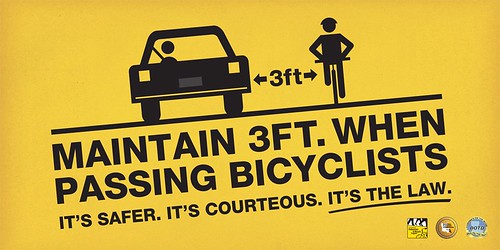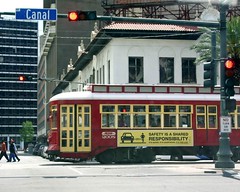Proposals for bicycle improvements at the state level in Maryland
One of the sections of the plan I wrote for Western Baltimore County that didn't make it out of the internal review process was a series of recommendations with regard to the State of Maryland, and how it handles certain bicycle and/or pedestrian related transportation policies and practices.
Typically, a local jurisdiction doesn't like to provide such recommendations, because they have no control within their processes over recommendations with regard to "higher levels" of government. I argued for including these provisions because "in theory, planners are supposed to add to and extend theory" and because these kinds of disconnects or incongruencies are uncovered at the local level, and if not communicated, it's not ever likely that the programs at the state level are clued into the disconnects.
So I am offering that section here:
State of Maryland policies
[deleted] is committed to working with other jurisdictions and agencies to develop congruent policies and programs to achieve mutually desirable improvements that support and extend a positive environment for walking and bicycling.
In the process of developing the Pedestrian and Bicycle Access Plan, a number of state policies were identified that with improvements, could provide stronger support to pedestrian and bicycle goals at the local level, in keeping with the goals and objectives of the State of Maryland 20 Year Bicycle & Pedestrian Access Master Plan.
1. Complete Streets requirements. The State Highway Administration has complete streets design requirements, which require that improvements to the pedestrian and bicycling environment be made to the greatest extent possible in all road projects. By extending the requirement for pedestrian and bicyclist accommodation to other state agencies, including siting decisions for public facilities either built for use by state agencies or funded by state agencies (such as the construction of local schools), smart growth and sustainable transportation objectives will be more easily achieved.
2. Balanced transportation planning for local school districts. The most successful walk and bicycle to school programs occur as part of system wide planning and programming at the level of an entire school district. For example, school districts in Minneapolis and Boulder (among others), provide support for walk and bicycle to school programs as part of comprehensive transportation services including but not limited to the provision of bus transportation. The State of Washington requires that safe walk maps be created for all elementary schools in each school district in the state, and recommends that districts create a Traffic Safety Committee to address walk to school issues. Similar requirements in Maryland would accelerate the development of systematic and structured programs for entire school districts, which would be preferred over the ad hoc practices currently in force.
3. State university master plan requirements. State law requires that universities update their campus master plans every five years to ensure that facilities meet the institutions' needs. These requirements should include mandates for sustainable transportation planning and coordination with local jurisdictions.
4. Expanded share the road education via the Department of Motor Vehicles. At each of the four citizen workshops held in April 2010 for the Western Baltimore County Pedestrian and Bicycle Access Plan, a consensus recommendation was that “share the road” education for all modes (pedestrians, bicyclists, motorists) needed to be strengthened and improved.
While the Maryland Department of Motor Vehicles guidebook The Rules of the Road for Cars, Trucks, Motorcycles, Pedestrians and Bicyclists covers the respective laws appropriately and clearly, since it is rare for people to re-take the written test after the receipt of their initial driver’s license, perhaps the development of and the subsequent administration of a written “refresher” test on matters concerning “sharing the road” could occur as part of the driver’s license renewal process. Also, the curriculum for Driver’s Education training programs should be examined and if necessary, training and exercises with regard to pedestrian and bicyclist safety should be enhanced.
5. Commercial Driver’s License Requirements and “share the road” education and training. Similarly, the operators of commercial vehicles, especially heavy vehicles, could be encouraged to undergo additional training with regard to safe travel practices concerning pedestrians and bicyclists, as part of the license application and renewal process.
6. Expanding the curriculum for pedestrian and bicycling training for children and youth. Currently, the SHA-funded curriculum covers pedestrian topics for K-1 grades, and bicycling for grades 1-3. Developing standardized curricula for higher grades is likely in order, given the prevalence of pedestrian- and bicycle-related safety incidents involving older children and youth combined with research findings in neurology showing that the brain begins its final stages of maturation during adolescence and continues to rapidly develop well into a person’s early 20s. Therefore, new curricula/educational programs should probably be developed for older children, targeting grades 4/5, middle schools, and high school aged children. This would provide a complete and continuous pedestrian and bicycle safety educational programming for all grade levels throughout the K-12 educational process.
7. StreetSmart advertising program and the “3 feet” rule. The StreetSmart advertising campaign, funded in part by the Maryland Highway Safety Office, should expand the program to include new advertisements communicating the new state law. Below are examples from a campaign by the Regional Planning Commission for Jefferson, Orleans, Plaquemines, St. Bernard and St. Tammany Parishes in Greater New Orleans. This campaign was brought to the study team’s attention by one of the attendees at the Citizen Workshop held in Catonsville (Baltimore County Council District 1).
Billboard advertisement promoting safer passing around bicyclists, New Orleans. Images courtesy of the New Orleans Regional Planning Agency..
Advertising placard affixed to a streetcar in New Orleans.
8. State of Maryland transportation enhancement program match requirements. Of all the state participants, Maryland’s requirement for local match, 50%, is the highest. This requirement is significantly higher than all of the states bordering Maryland. West Virginia and DC have a 20% match. Virginia also has a 20% match requirement, but will fully fund projects under $200,000. Delaware requires a 2% match/$100,000 of award, while Pennsylvania does not require match, considering local expenditures on preconstruction planning to satisfy match requirements. By comparison to Maryland, the bordering states have a larger and more geographically diverse number of jurisdictions participating in their enhancement program. It may be worth evaluating Maryland’s program requirements for local jurisdiction participation in the transportation enhancement program, in order to increase the number of jurisdictions actively participating, and to bring the State’s utilization of the available funding closer to 100% of available funds, versus the roughly 80% that is actually obligated.
Labels: bicycling, change-innovation-transformation, transportation planning, walking





1 Comments:
Thank you for providing such a valuable information and thanks for sharing this matter.
Post a Comment
<< Home